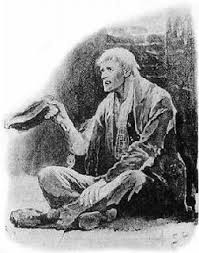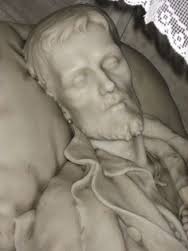
 Summary: St Benedict Joseph Labre is the patron saint of beggars and the homeless. Born in Boulogne, France, he spent most of his life as a beggar in Rome.
Summary: St Benedict Joseph Labre is the patron saint of beggars and the homeless. Born in Boulogne, France, he spent most of his life as a beggar in Rome.
Fr John Murray PP tells his story.
I became aware of the man beside me and the most overpowering smell which came from him’. The smell was so strong I could scarcely breathe. He was not one of the priests but a ‘gentleman of the road’ who had wandered in and sat down to join in the prayers. I would like to tell you that like Martin of Tours I divided my coat in two and gave him half, or like Francis of Assisi I embraced him at the end, but I did neither. When the prayers ended I moved quickly away.‘
I tell this story against myself. It happened some years ago and I hope that God has changed me for the better in the meantime. And yet my reaction to my fellow human being might well have been the reaction of many when they met the saint whom I share with you this month (April 09). Benedict Joseph Labre probably evoked similar feelings in many who encountered him, and yet when he died the cry went up ‘the saint is dead! the saint is dead!’
Benedict was born in 1748 near Boulogne in France, the eldest of fifteen children. His parents were respectable, held in high regard by all who knew them. There were also some priests on both sides of the family. From an early age he too was attracted by the spiritual life and told his parents that he wished to join the La Trappe monastery, which was a more austere branch of the Cistercians. His parents were against such a step because of the severity of the rule and Benedict was obedient in the end to their wishes. In time he felt they would come round to his way of thinking.
At this time Benedict was particularly close to one of his uncles who was a priest. Fr. Francis was a director and confidante to the young man. However, in the summer of 1766 there was a fierce epidemic in the area. Both men were fully occupied bringing practical help and spiritual succour to all who were afflicted by the disease. Sadly, as a result of his exertions, Francis died and Benedict had lost a friend and advisor.
 Benedict returned to his earlier idea of entering the Trappist community, but this time was refused because of his youth. He was likewise refused by a series of other religious communities. Thus discouraged, he discerned that his true vocation was to seek a cloister within the world. Accordingly, he set off by foot on a pilgrimage that lasted several years, wandering thousands of miles across Europe and taking in many of the principal shrines and churches. He dressed in rags and never bathed. This certainly discouraged human contact and thus contributed to the prayerful isolation which he relished. At the same time, he declined to beg, though passers-by often were moved to give him alms. When food was not offered he simply lived off what he might find at the side of the road.
Benedict returned to his earlier idea of entering the Trappist community, but this time was refused because of his youth. He was likewise refused by a series of other religious communities. Thus discouraged, he discerned that his true vocation was to seek a cloister within the world. Accordingly, he set off by foot on a pilgrimage that lasted several years, wandering thousands of miles across Europe and taking in many of the principal shrines and churches. He dressed in rags and never bathed. This certainly discouraged human contact and thus contributed to the prayerful isolation which he relished. At the same time, he declined to beg, though passers-by often were moved to give him alms. When food was not offered he simply lived off what he might find at the side of the road.
His appearance was as likely to evoke contempt as pity, and he was indeed frequently harassed. Nevertheless, Benedict accepted all this in a spirit of penance. When a priest in the confessional once asked him if he had ever studied theology, Benedict replied ‘I Father? I am only a poor beggar’. Those who were able to see beneath his dishevelled appearance – including eventually his confessor – recognised the saint in their midst.
Eventually Benedict settled in Rome, where he spent his nights sleeping in the ruins of the Colosseum, where many of the early Christians had been martyred. His days he spent praying in many of the beautiful churches which adorned the city. When his health began to fail, he consented to sleep in a hospice for the destitute. However, this belated concession to human frailty could not reverse the damage done to his health. At the age of 35 he collapsed on the steps of a church and was carried to a nearby house. There he died on April 16th 1783.
 Almost immediately the local children took up the cry which I mentioned earlier ‘the saint is dead!‘ His reputation spread rapidly through the city and then the rest of Europe. It was through one of these accounts of his life that his parents – still alive at this time – heard of the whereabouts of their ‘lost’ son. He was canonised in 1883.
Almost immediately the local children took up the cry which I mentioned earlier ‘the saint is dead!‘ His reputation spread rapidly through the city and then the rest of Europe. It was through one of these accounts of his life that his parents – still alive at this time – heard of the whereabouts of their ‘lost’ son. He was canonised in 1883.
What are the lessons of such a life for us who live in a world of ‘designer labels’ and fast food, where appearances and soundbites mean so much to some people? Can we take time to ‘see’ that man or woman whom we pass downtown? Could we spare ten seconds to look into their eyes next time we drop a few coins into the plastic cup? Might we take a bit longer to share a few words of conversation and ask their name or where they have come from? Who knows, we might even be meeting a Benedict Joseph today!
Many years ago I had the privilege of hearing Mother Teresa at another gathering of priests. She shared how often there was more poverty in the streets of London or New York than in Calcutta. Once while walking through the streets of London a hand shot out from a doorway, looking for money. She carried none but instead took the hand in hers and held it for a while. Then a voice from the doorway said: ‘Such a long time since I held the warmth of a human hand, such a long time.’